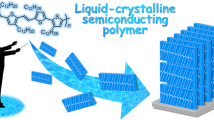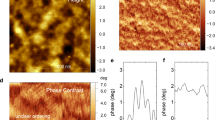Abstract
Organic semiconductors that can be fabricated by simple processing techniques and possess excellent electrical performance, are key requirements in the progress of organic electronics. Both high semiconductor charge-carrier mobility, optimized through understanding and control of the semiconductor microstructure, and stability of the semiconductor to ambient electrochemical oxidative processes are required. We report on new semiconducting liquid-crystalline thieno[3,2-b ]thiophene polymers, the enhancement in charge-carrier mobility achieved through highly organized morphology from processing in the mesophase, and the effects of exposure to both ambient and low-humidity air on the performance of transistor devices. Relatively large crystalline domain sizes on the length scale of lithographically accessible channel lengths (∼200 nm) were exhibited in thin films, thus offering the potential for fabrication of single-crystal polymer transistors. Good transistor stability under static storage and operation in a low-humidity air environment was demonstrated, with charge-carrier field-effect mobilities of 0.2–0.6 cm2 V−1 s−1 achieved under nitrogen.
This is a preview of subscription content, access via your institution
Access options
Subscribe to this journal
Receive 12 print issues and online access
$259.00 per year
only $21.58 per issue
Buy this article
- Purchase on Springer Link
- Instant access to full article PDF
Prices may be subject to local taxes which are calculated during checkout





Similar content being viewed by others
References
Katz, H. E. Recent advances in semiconductor performance and printing processes for organic transistor-based electronics. Chem. Mater. 16, 4748–4756 (2004).
Chabinyc, M. L. & Salleo, A. Materials requirements and fabrication of active matrix arrays of organic thin film transistors for displays. Chem. Mater. 16, 4509–4521 (2004).
Sirringhaus, H. et al. Two-dimensional charge transport in self-organized, high-mobility conjugated polymers. Nature 401, 685–688 (1999).
Jurchescu, O. D., Baas, J. & Palstra, T. T. M. Effect of impurities on the mobility of single crystal pentacene. Appl. Phys. Lett. 84, 3061–3063 (2004).
Podzorov, V., Sysoev, S. E., Loginova, E., Pudalov, V. M. & Gershenson, M. E. Single-crystal organic field effect transistors with the hole mobility. Approx. 8 cm2/Vs . Appl. Phys. Lett. 83, 3504–3505 (2003).
Baude, P. F. et al. Pentacene-based radio-frequency identification circuitry. Appl. Phys. Lett. 82, 3964–3966 (2003).
Payne, M. M., Parkin, S. R., Anthony, J. E., Kuo, C. C. & Jackson, T. N. Organic field-effect transistors from solution-deposited functionalized acenes with mobilities as high as 1 cm2/V·s . J. Am. Chem. Soc. 127, 4986–4987 (2005).
Sirringhaus, H., Tessler, N. & Friend, R. H. Integrated optoelectronic devices based on conjugated polymers. Science 280, 1741–1744 (1998).
Bao, Z., Dobabalapur, A. & Lovinger, A. J. Soluble and processable regioregular poly(3-hexylthiophene) for thin film field-effect transistor applications with high mobility. Appl. Phys. Lett. 69, 4108–4110 (1996).
Prosa, T. J., Wimokur, M. J., Moulton, J., Smith, P. & Heeger, A. J. X-ray structural studies of poly(3-alkylthiophenes): An example of an inverse comb. Macromolecules 25, 4364–4372 (1992).
Ong, B. S., Wu, Y., Liu, P. & Gardner, S. High-performance semiconducting polythiophenes for organic thin-film transistors. J. Am. Chem. Soc. 126, 3378–3379 (2004).
McCulloch, I. et al. Influence of molecular design on field-effect transistor characteristics of terthiophene polymers. Chem. Mater. 17, 1381–1385 (2005).
Zhao, N. et al. Microscopic studies on liquid crystal poly(3,3′′′ -dialkylquaterthiophene) semiconductor. Macromolecules 37, 8307–8312 (2004).
Street, R. A., Northrup, J. E. & Salleo, A. Transport in polycrystalline polymer thin-film transistors. Phys. Rev. B 71, 165202 (2005).
McCullough, R. The chemistry of conducting polythiophenes. Adv. Mater. 10, 93–116 (1998).
Brennan, D. J. et al. Recent advances in the synthesis of polyfluorenes as organic semiconductors. Mater. Res. Soc. Symp. Proc. 814, 1–12 (2004).
Heeney, M. et al. Alkylidene fluorene liquid crystalline semiconducting polymers for organic field effect transistor devices. Macromolecules 37, 5250–5256 (2004).
Kline, J. R., McGehee, M. D., Kadnikova, E. N., Liu, J. & Frechet, J. M. J. Controlling the field-effect mobility of regioregular polythiophene by changing the molecular weight. Adv. Mater. 15, 1519–1522 (2003).
Babel, A. & Jenekhe, S. A. Field-effect mobility of charge carriers in blends of regioregular poly(3-alkylthiophene)s. J. Phys. Chem. B 107, 1749–1754 (2003).
Yang, H. C. et al. Effect of mesoscale crystalline structure on the field-effect mobility of regioregular poly(3-hexylthiophene) in thin-film transistors. Adv. Funct. Mater. 15, 671–676 (2005).
Kline, R. J. et al. Dependence of regioregular poly(3-hexylthiophene) film morphology and field-effect mobility on molecular weight. Macromolecules 38, 3312–3319 (2005).
Heeney, M. et al. Stable polythiophene semiconductors incorporating thieno[2,3-b]thiophene. J. Am. Chem. Soc. 127, 1078–1079 (2005).
Salleo, A. et al. Intrinsic hole mobility and trapping in a regioregular poly(thiophene). Phys. Rev. B 70, 115311 (2004).
Meijer, E. J. et al. Dopant density determination in disordered organic field-effect transistors. J. Appl. Phys. 93, 4831–4835 (2003).
Leeuw, D. M. d., Simenon, M. M. J., Brown, A. R. & Einerhand, R. E. F. Stability of n-type doped conducting polymers and consequences for polymeric microelectronic devices. Synth. Met. 87, 53–59 (1997).
Xia, Y., Rogers, J. A., Paul, K. E. & Whitesides, G. M. Unconventional methods for fabricating and patterning nanostructures. Chem. Rev. 99, 1823–1848 (1999).
Sele, C. W., von Werne, T., Friend, R. H. & Sirringhaus, H. Lithography-free, self-aligned inkjet printing with sub-hundred nanometer resolution. Adv. Mater. 17, 997–1001 (2005).
Tierney, S., Heeney, M. & McCulloch, I. Microwave-assisted synthesis of polythiophenes via the stille coupling. Synth. Met. 148, 195–198 (2005).
Toney, M. F. & Wiesler, D. G. Instrumental effects on measurements of surface x-ray diffraction rods: Resolution function and active sample area. Acta Crystallogr. A 49, 624–642 (1993).
Sano, T., Hamada, Y. & Shibata, K. Energy-band schemes of highly stable organic electroluminescent devices. IEEE J. Sel. Top. Quantum Electron. 4, 34–39 (1998).
Acknowledgements
Portions of this research were carried out at the Stanford Synchrotron Radiation Laboratory, a user facility operated by Stanford University on behalf of the US Department of Energy, Office of Basic Energy Sciences.
Author information
Authors and Affiliations
Corresponding author
Ethics declarations
Competing interests
The authors declare no competing financial interests.
Supplementary information
Supplementary Information
Supplementary information and figures 1 and 2 (PDF 165 kb)
Rights and permissions
About this article
Cite this article
McCulloch, I., Heeney, M., Bailey, C. et al. Liquid-crystalline semiconducting polymers with high charge-carrier mobility. Nature Mater 5, 328–333 (2006). https://doi.org/10.1038/nmat1612
Received:
Accepted:
Published:
Issue Date:
DOI: https://doi.org/10.1038/nmat1612
This article is cited by
-
Ordered π-conjugated polymer backbone in amorphous blend for high efficiency nonfullerene organic photovoltaics
Communications Materials (2023)
-
A materials physics perspective on structure–processing–function relations in blends of organic semiconductors
Nature Reviews Materials (2023)
-
Heterogeneous Oriented Structure model of thermoelectric transport in conducting polymers
Scientific Reports (2023)
-
Doping of molecular semiconductors through proton-coupled electron transfer
Nature (2023)
-
Formation of hierarchically ordered structures in conductive polymers to enhance the performances of lithium-ion batteries
Nature Energy (2023)



